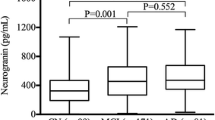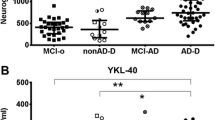Abstract
Objective
Neurogranin is a postsynaptic protein involved in long-term potentiation and synaptic plasticity. Recent studies have shown increased neurogranin levels in the cerebrospinal fluid of Alzheimer’s disease patients, and in patients with mild cognitive impairment.
Method
We searched the online databases for studies on neurogranin cerebrospinal fluid levels in Alzheimer’s disease, mild cognitive impairment and other neurodegenerative disorders, and we did a meta-analysis to clarify whether this can be a reliable biomarker for the diagnosis of Alzheimer’s disease, and the discrimination from other disorders.
Results
The present meta-analysis showed that neurogranin CSF levels are significantly higher in AD patients compared to NC [SMD: 268.26, 95% CI (143.47, 393.04), Z = 4.21, P = 0.0001], MCI [SMD: 23.45 (15.97, 30.92), Z = 6.15, P < 0.00001], FTD [SMD: 1.91 (0.92, 2.89), Z = 3.80, P < 0.0001], but no significant difference was found between AD and LBD [SMD: 138.51 (− 14.92, 291.95), Z = 1.77, P = 0.08]. Comparison of stable MCI and MCI that progressed to AD showed significantly higher levels in the CSF of MCI patients who progressed to AD, compared to stable MCI patients [SMD: 230.84 (12.54, 449.14), Z = 2.07, P = 0.04]. Neurogranin can also be a useful biomarker for the differentiation MCI and NC, but not between MCI and FTD or LBD.
Conclusion
Neurogranin could be added to the panel of existing biomarkers for a more accurate diagnosis and progress of AD and assessment of underlying pathological changes in the brain.











Similar content being viewed by others
References
Gerendasy DD, Sutcliffe JG (1997) RC3/neurogranin, a post-synaptic calpacitin for setting the response threshold to calcium influxes. Mol Neurobiol 15:131–163
Kaleka KS, Gerges NZ (2016) Neurogranin restores amyloid-mediated synaptic transmission and long-term potentiation deficits. Exp Neurol 277:115–123
Davidsson P, Blennow K (1998) Neurochemical dissection of synaptic pathology in Alzheimer’s disease. Int Psychogeriatr 10:11–23
Reddy PH, Mani G, Park BS et al (2005) Differential loss of synaptic proteins in Alzheimer’s disease: implications for synaptic dysfunction. J Alzheimers Dis 7:103–117
Thorsell A, Bjerke M, Gobom J et al (2010) Neurogranin in cerebrospinal fluid as a marker of synaptic degeneration in Alzheimer’s disease. Brain Res 1362:13–22
De Vos A, Jacobs D, Struyfs H et al (2015) C-terminal neurogranin is increased in cerebrospinal fluid but unchanged in plasma in Alzheimer’s disease. Alzheimers Dement 11:1461–1469
Kester MI, Teunissen CE, Crimmins DL et al (2015) Neurogranin as a cerebrospinal fluid biomarker for synaptic loss in symptomatic Alzheimer disease. JAMA Neurol 72:1275–1280
Kvartsberg H, Duits FH, Ingelsson M et al (2015) Cerebrospinal fluid levels of the synaptic protein neurogranin correlates with cognitive decline in prodromal Alzheimer’s disease. Alzheimers Dement 11:1180–1190
Kvartsberg H, Portelius E, Andreasson U et al (2015) Characterization of the post-synaptic protein neurogranin in paired cerebrospinal fluid and plasma samples from Alzheimer’s disease patients and healthy controls. Alzheimers Res Ther 7:40
Hozo SP, Djulbegovic B, Hozo I (2005) Estimating the mean and variance from the median, range, and the size of a sample. BMC Med Res Methodol 20:13
Portelius E, Olsson B, Höglund K et al (2018) Cerebrospinal fluid neurogranin concentration in neurodegeneration: relation to clinical phenotypes and neuropathology. Acta Neuropathol 136:363–376
Tarawneh R, D’Angelo G, Crimmins D et al (2016) Diagnostic and prognostic utility of the synaptic marker neurogranin in Alzheimer disease. JAMA Neurol 73:561–571
Janelidze S, Hertze J, Zetterberg H et al (2015) Cerebrospinal fluid neurogranin and YKL-40 as biomarkers of Alzheimer’s disease. Ann Clin Transl Neurol 3:12–20
Pereira JB, Westman E, Hansson O (2017) Alzheimer’s disease neuroimaging initiative. Association between cerebrospinal fluid and plasma neurodegeneration biomarkers with brain atrophy in Alzheimer’s disease. Neurobiol Aging 58:14–29
Kirsebom BE, Nordengen K, Selnes P et al (2018) Cerebrospinal fluid neurogranin/β-site APP-cleaving enzyme 1 predicts cognitive decline in preclinical Alzheimer’s disease. Alzheimers Dement (N Y) 10:617–627
De Vos A, Struyfs H, Jacobs D et al (2016) The cerebrospinal fluid neurogranin/BACE1 ratio is a potential correlate of cognitive decline in Alzheimer’s disease. J Alzheimers Dis 53:1523–1538
Wang L (2019) Association of cerebrospinal fluid Neurogranin with Alzheimer’s disease. Alzheimer’s disease neuroimaging initiative. Aging Clin Exp Res 31:185–191
Headley A, De Leon-Benedetti A, Dong C et al (2018) Neurogranin as a predictor of memory and executive function decline in MCI patients. Alzheimer’s disease neuroimaging initiative. Neurology 90:e887–e895
Sanfilippo C, Forlenza O, Zetterberg H et al (2016) Increased neurogranin concentrations in cerebrospinal fluid of Alzheimer’s disease and in mild cognitive impairment due to AD. J Neural Transm (Vienna) 123:1443–1447
Lista S, Toschi N, Baldacci F et al (2017) Alzheimer Precision Medicine Initiative (APMI). Cerebrospinal fluid neurogranin as a biomarker of neurodegenerative diseases: a cross-sectional study. J Alzheimers Dis 59:1327–1334
Zhong L, Cherry T, Bies CE et al (2009) Neurogranin enhances synaptic strength through its interaction with calmodulin. EMBO J 28:3027–3039
Pak JH, Huang FL, Li J et al (2000) Involvement of neurogranin in the modulation of calcium/calmodulin-dependent protein kinase II, synaptic plasticity, and spatial learning: a study with knockout mice. Proc Natl Acad Sci USA 97:11232–11237
Scheff SW, Price DA, Schmitt FA et al (2006) Hippocampal synaptic loss in early Alzheimer’s disease and mild cognitive impairment. Neurobiol Aging 27:1372–1384
Maiti P, Manna J, Ilavazhagan G et al (2015) Molecular regulation of dendritic spine dynamics and their potential impact on synaptic plasticity and neurological diseases. Neurosci Biobehav Rev 59:208–237
Author information
Authors and Affiliations
Corresponding author
Ethics declarations
Conflict of interest
The authors declare that they have no conflict of interest.
Ethical approval
This article is a review of other studies, and therefore no ethical approval needed.
Statement of human and animal rights
The present study is a meta-analysis of other studies on humans, and as stated on the individual studies they conducted in accordance with the ethical standards.
Informed consent
For this type of study formal consent is not required.
Additional information
Publisher's Note
Springer Nature remains neutral with regard to jurisdictional claims in published maps and institutional affiliations.
Rights and permissions
About this article
Cite this article
Mavroudis, I.A., Petridis, F., Chatzikonstantinou, S. et al. A meta-analysis on CSF neurogranin levels for the diagnosis of Alzheimer’s disease and mild cognitive impairment. Aging Clin Exp Res 32, 1639–1646 (2020). https://doi.org/10.1007/s40520-019-01326-z
Received:
Accepted:
Published:
Issue Date:
DOI: https://doi.org/10.1007/s40520-019-01326-z




